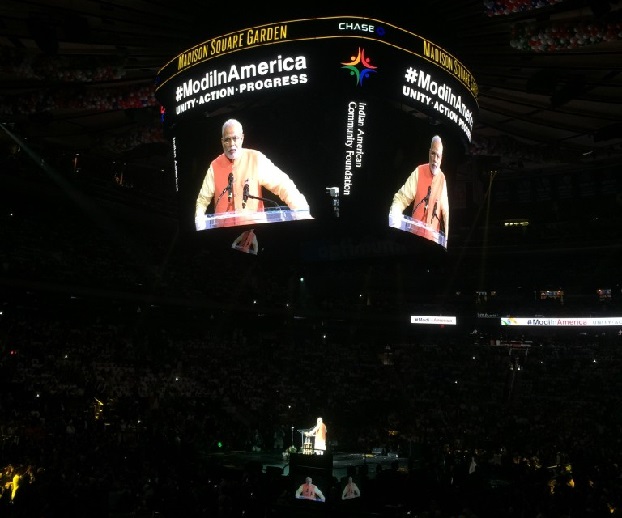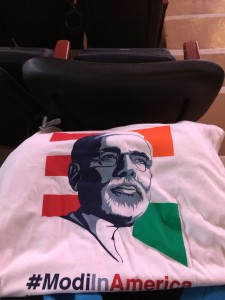
“Why?”
If I had a nickel for every time someone asked me last week why I was going to the Narendra Modi event in Madison Square Garden on Sunday, I’d be rich. As a queer South Asian woman, I can see why those who know me best were surprised that I was willing to attend. From his lack of action on IPC 377, to his silence on violence against women, to his murky past with religious minorities, the reasons to be weary of Modi have been plentiful. To be honest, it wasn’t until I was in the arena, surrounded by more than 18,000 Indian Americans, clutching a #ModiInAmerica t-shirt, that I realized why I felt the need to be there.
Modi’s arrival in the US this past week created quite an uproar. Multiple headlines [pullquote]I wore my SALGA-NYC shirt, giving me a sense of community, even when I felt all alone in a sea of Modi supporters.[/pullquote]of a ‘rockstar’ welcome preceded his big speech on Sunday, and the use of that word made me wonder why it seemed that way to news outlets around the world. This event was certainly unprecedented — a newly elected leader of country halfway around the world, who had previously been banned from entering the U.S., was being thrown a large-scale reception by his own people (not like, the President). Calling him a rockstar also alluded to the decisive way Modi was elected to office earlier this year, with the first full parliamentary majority being elected in over a decade, and over 550 million people casting their ballots. A sense of hope ushered in Modi’s age, and I have long wondered what all the hype was about.
I sat in my seat for over an hour before the event was to begin, eating an overpriced bagel from the concession stand. I clutched the free #ModiInAmerica t-shirt I got as I entered, but I wore my SALGA-NYC shirt, which gave me a sense of community, even when I felt all alone in a sea of Modi supporters. It would be so easy to mistake me for one of them. I wanted to wave a rainbow flag instead of the Indian ones they had passed out. I jumped on Twitter, seeing pictures of friends and allies just outside the arena, protesting the event. I felt hypocritical and invisible. I knew Modi didn’t care that I wanted answers — he wasn’t here for me, and maybe I wasn’t there for him. I grew uneasy among chants of Modi’s name.
Pre-game #modiinamerica with @NinaDavuluri pic.twitter.com/d4iPQGvkLY
— hari sreenivasan (@hari) September 28, 2014
Hosted by Hari Srinivasan (CNN) and Nina Davuluri (Former Miss America), the #ModiAtMadison event kicked off with a prayer and a number of dance performances that were at times as elaborate as the Filmfare Awards (insane costumes and headdresses) and at others, as confusing as watching a cultural talent show no one knew the theme of (songs performed included Chak De India and Jai Ho, alongside Born in the USA). Making a special appearance was Kavita Krishnamurthy and her violinist husband L. Subramaniam performing “I Love My India” from the Bollywood movie Pardes. I momentarily forgot my unease, singing along to a tune with such depth and meaning.
As the hour of entertainment wore on, more [pullquote align=”right”]I was in a room full of Indians from all over the diaspora, who had gathered here because they love their country, in some way or another.[/pullquote]chants filled the arena between acts. Some chanted Modi’s name, some called “Bharat Mata ki Jai” (Long Live India), while others simply repeated “USA, USA!” It was an eclectic and electrifying atmosphere.
As the arena filled up closer to Modi’s scheduled appearance, I felt my discomfort fade and another feeling grow: a sense of camaraderie. I was in a room full of Indians from all over the diaspora, who had gathered here because they love their country, in some way or another.
Finally, Modi was introduced before Kavita Krishnamurthy returned to sing the Indian National Anthem. I’ve never heard a roar quite as loud as the one that greeted Modi, and I’ve been to a lot of sporting events and concerts. As I recited the Indian national anthem, along with thousands of others, I was nearly overcome with emotion and hope. I was here, in the heart of this historic event for India. Could India finally make a mark on the world map? Could we live up to being the world’s largest democracy? Could we stop being ashamed of the way we treat our women and religious minorities? Modi’s hope and promise brought us here. Maybe, just maybe, I wasn’t the only one cautiously optimistic for change.

Modi spoke for over an hour in Hindi, and left quite an impression. He worked the crowd, throwing in humorous anecdotes, and asking repeatedly if we were with him. Speaking repeatedly about Gandhi, Modi spoke of turning this historic election and desire for change into a movement. He even asked at one point, “Gandhi gave us independence, what have we given him?” Modi referred to a plan for making India cleaner, and the milestones he wanted to achieve by 2015, 2019, and 2022. He talked a lot about history, such as commemorating a hundred years since Gandhi’s return to India from South Africa (2015), a hundred fifty years since Gandhi’s birth (2019), and a vision for every person in India living in their own house (2022).
Charismatic and charming, Modi talked big. He made big promises. For the most part, it all made sense. India is on track to be the youngest country by 2020, with 65 percent of the population being under 35. It’s easy to see why Modi appeals to this youthful population. He speaks with confidence and valor, asking why India shouldn’t be cleaner, more in demand, and respect itself. They were all valid points, but one also couldn’t help notice the visible lack of religious minorities in the room.
There was no mention of women’s rights or violence against women, nor of the outdated 377, as Modi talked proudly about appointing a committee to [pullquote]I waited for an example, to hear myself in his words. It never came.[/pullquote]get rid of old and outdated laws. The crowd laughed as Modi said if that committee got rid of even one law a day, it would be the happiest day of his life.
I waited for an example, to hear myself in his words. It never came. Modi was effective and passionate. But he also didn’t offer much new information, often reiterating points he had given in his Independence Day speech last month (such as his new ‘Make in India’ initiative). Besides a mention of the Mars mission, which elicited loud cheers from the crowd, I felt like Modi was running a campaign speech. We want change, and he knows that’s what got him elected. But now it’s time to show up — I’m willing to give him a chance to prove himself, even though his turbulent past cannot be forgotten.
Thousands of Indian-Americans gather at Madison Square Garden to hear Indian PM Narendra #Modi http://t.co/ESq4dh1j0z pic.twitter.com/mUFqUIds0L — BBC News (World) (@BBCWorld) September 28, 2014
The speech ended with Modi promising the arena full of NRIs the India of their dreams. I think Modi meant that in his own way, but he could never possibly know the broad spectrum of dreams that lives in the hearts of members of the Indian diaspora. Making the Ganges cleaner and visas easier to attain is important, but women’s rights and minority rights are too. [pullquote]I needed to see what all the hype was about, and I needed to form my own opinion of Modi.[/pullquote]I realized why I went to the speech. I needed to see what all the hype was about, and I needed to form my own opinion of Modi.
I’m thankful to my parents, for not only teaching me Hindi (so I could follow Modi’s speech without the poor English translations that appeared on the large screens), but also for keeping their love for India alive after over three decades in America. I followed the elections because of my parents, and because of them, I was invested in the outcome. I want to take my children back to a better India, a feeling I don’t think they’ve had for a long time. And throughout my discomfort about attending the speech this whole week, my parents were the only ones who didn’t ask why. My mom admired my curiosity as an activist, and my dad commended my willingness to be open-minded.
Hundreds of people — atheist, Hindu, Sikh, Muslim — gather to protest #hindutva at #ModiInAmerica #ModiInUS pic.twitter.com/iDHsAMt67X — DarkMatter (@DarkMatterRage) September 28, 2014
As I left the arena, I was disappointed to have seen so little of my own vision for India in Modi’s vision. Across the way, hundreds of people from communities I also identify with, stood patiently and in solidarity, protesting the event. I walked past them, feeling unsure of why I hadn’t joined them, how my love for India took me past those doors, and why I could never be a Modi supporter.
I’m proud to be a queer South Asian woman, and I don’t need to be a Modi supporter to believe in India’s bright future. That’s why I needed to be there Sunday — and I’m glad I was.
* * *
Born and raised in California, Priya Arora has found a home in New York where she currently attends Teachers College at Columbia University. Follow her on Twitter at @thepriyaarora.













1 thought on “Why I Went To See Narendra Modi At Madison Square Garden”
Comments are closed.